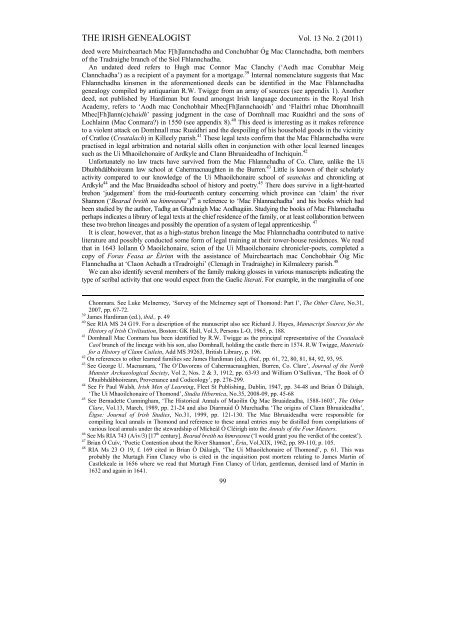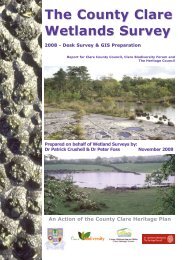A Mac Fhlannchadha Fosterage Document, c.1580 - Clare County ...
A Mac Fhlannchadha Fosterage Document, c.1580 - Clare County ...
A Mac Fhlannchadha Fosterage Document, c.1580 - Clare County ...
You also want an ePaper? Increase the reach of your titles
YUMPU automatically turns print PDFs into web optimized ePapers that Google loves.
THE IRISH GENEALOGIST Vol. 13 No. 2 (2011)deed were Muircheartach <strong>Mac</strong> F[h]lannchadha and Conchubhar Óg <strong>Mac</strong> Clannchadha, both membersof the Tradraighe branch of the Síol <strong>Fhlannchadha</strong>.An undated deed refers to Hugh mac Connor <strong>Mac</strong> Clanchy (‘Aedh mac Conubhar MeigClannchadha’) as a recipient of a payment for a mortgage. 39 Internal nomenclature suggests that <strong>Mac</strong><strong>Fhlannchadha</strong> kinsmen in the aforementioned deeds can be identified in the <strong>Mac</strong> <strong>Fhlannchadha</strong>genealogy compiled by antiquarian R.W. Twigge from an array of sources (see appendix 1). Anotherdeed, not published by Hardiman but found amongst Irish language documents in the Royal IrishAcademy, refers to ‘Aodh mac Conchobhair Mhec[Fh]lannchaoidh’ and ‘Flaithrí mhac DhomhnaillMhec[Fh]lann(c)chaidh’ passing judgment in the case of Domhnall mac Ruaídhrí and the sons ofLochlainn (<strong>Mac</strong> Conmara?) in 1550 (see appendix 8). 40 This deed is interesting as it makes referenceto a violent attack on Domhnall mac Ruaídhrí and the despoiling of his household goods in the vicinityof Cratloe (Creatalach) in Killeely parish. 41 These legal texts confirm that the <strong>Mac</strong> <strong>Fhlannchadha</strong> werepractised in legal arbitration and notarial skills often in conjunction with other local learned lineagessuch as the Uí Mhaoilchonaire of Ardkyle and Clann Bhruaideadha of Inchiquin. 42Unfortunately no law tracts have survived from the <strong>Mac</strong> <strong>Fhlannchadha</strong> of Co. <strong>Clare</strong>, unlike the UíDhuibhdábhoireann law school at Cahermacnaughten in the Burren. 43 Little is known of their scholarlyactivity compared to our knowledge of the Uí Mhaoilchonaire school of seanchas and chronicling atArdkyle 44 and the <strong>Mac</strong> Bruaideadha school of history and poetry. 45 There does survive in a light-heartedbrehon ‘judgement’ from the mid-fourteenth century concerning which province can ‘claim’ the riverShannon (‘Bearad breith na himreasna’) 46 a reference to ‘<strong>Mac</strong> Fhlannachadha’ and his books which hadbeen studied by the author, Tadhg an Ghadraigh <strong>Mac</strong> Aodhagáin. Studying the books of <strong>Mac</strong> <strong>Fhlannchadha</strong>perhaps indicates a library of legal texts at the chief residence of the family, or at least collaboration betweenthese two brehon lineages and possibly the operation of a system of legal apprenticeship. 47It is clear, however, that as a high-status brehon lineage the <strong>Mac</strong> <strong>Fhlannchadha</strong> contributed to nativeliterature and possibly conducted some form of legal training at their tower-house residences. We readthat in 1643 Iollann Ó Maoilchonaire, scion of the Uí Mhaoilchonaire chronicler-poets, completed acopy of Foras Feasa ar Éirinn with the assistance of Muircheartach mac Conchobhair Óig MicFlannchadha at ‘Claon Achadh a tTradroighi’ (Clenagh in Tradraighe) in Kilmaleery parish. 48We can also identify several members of the family making glosses in various manuscripts indicating thetype of scribal activity that one would expect from the Gaelic literati. For example, in the marginalia of oneChonmara. See Luke McInerney, ‘Survey of the McInerney sept of Thomond: Part I’, The Other <strong>Clare</strong>, No.31,2007, pp. 67-72.39 James Hardiman (ed.), ibid., p. 4940See RIA MS 24 G19. For a description of the manuscript also see Richard J. Hayes, Manuscript Sources for theHistory of Irish Civilisation, Boston: GK Hall, Vol.3, Persons L-O, 1965, p. 188.41 Domhnall <strong>Mac</strong> Conmara has been identified by R.W. Twigge as the principal representative of the CreatalachCaol branch of the lineage with his son, also Domhnall, holding the castle there in 1574. R.W Twigge, Materialsfor a History of Clann Cuilein, Add MS 39263, British Library, p. 196.42 On references to other learned families see James Hardiman (ed.), ibid., pp. 61, 72, 80, 81, 84, 92, 93, 95.43See George U. <strong>Mac</strong>namara, ‘The O’Davorens of Cahermacnaughten, Burren, Co. <strong>Clare</strong>’, Journal of the NorthMunster Archaeological Society, Vol 2, Nos. 2 & 3, 1912, pp. 63-93 and William O’Sullivan, ‘The Book of ÓDhuibhdábhoireann, Provenance and Codicology’, pp. 276-299.44 See Fr Paul Walsh, Irish Men of Learning, Fleet St Publishing, Dublin, 1947, pp. 34-48 and Brian Ó Dálaigh,‘The Uí Mhaoilchonaire of Thomond’, Studia Hibernica, No.35, 2008-09, pp. 45-6845 See Bernadette Cunningham, ‘The Historical Annals of Maoilín Óg <strong>Mac</strong> Bruaideadha, 1588-1603’, The Other<strong>Clare</strong>, Vol.13, March, 1989, pp. 21-24 and also Diarmuid Ó Murchadha ‘The origins of Clann Bhruaideadha’,Éigse: Journal of Irish Studies, No.31, 1999, pp. 121-130. The <strong>Mac</strong> Bhruaideadha were responsible forcompiling local annals in Thomond and reference to these annal entries may be distilled from compilations ofvarious local annals under the stewardship of Mícheál Ó Cléirigh into the Annals of the Four Masters.46 See Ms RIA 743 (A/iv/3) [17 th century]. Bearad breith na himreasna (‘I would grant you the verdict of the contest’).47 Brian Ó Cuív, ‘Poetic Contention about the River Shannon’, Ériu, Vol.XIX, 1962, pp. 89-110, p. 105.48 RIA Ms 23 O 19, f. 169 cited in Brian Ó Dálaigh, ‘The Uí Mhaoilchonaire of Thomond’, p. 61. This wasprobably the Murtagh Finn Clancy who is cited in the inquisition post mortem relating to James Martin ofCastlekeale in 1656 where we read that Murtagh Finn Clancy of Urlan, gentleman, demised land of Martin in1632 and again in 1641.99
















